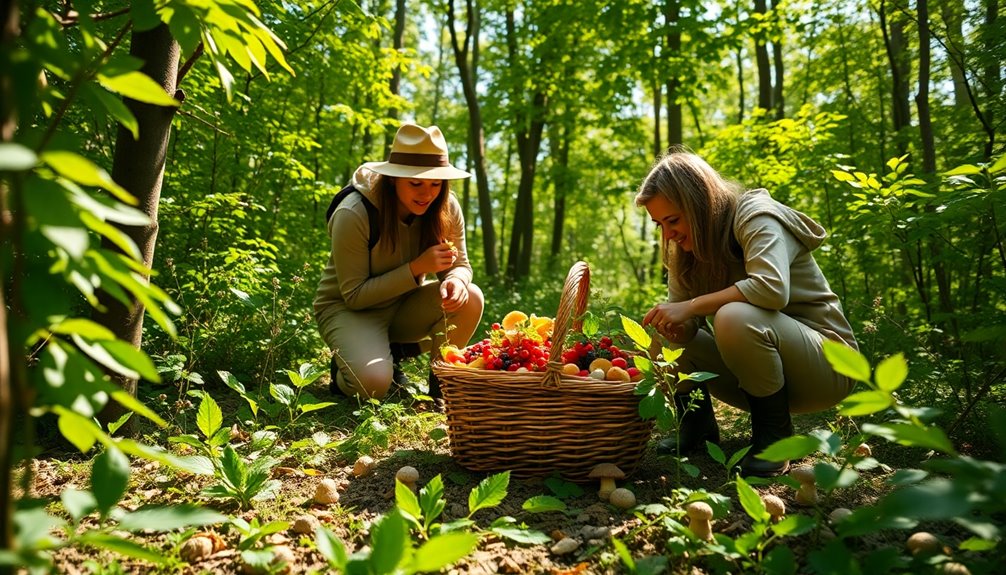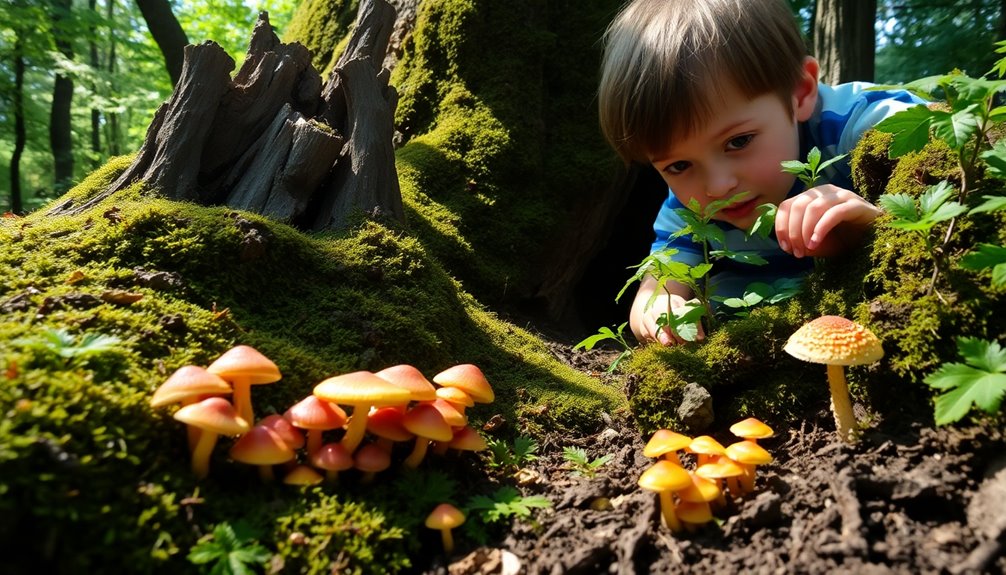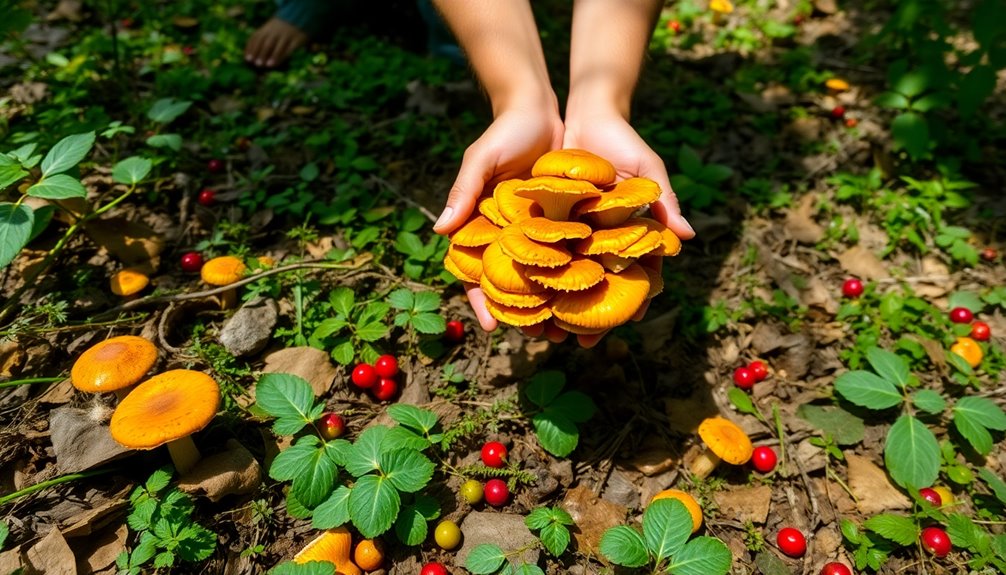Foraging societies, often called hunter-gatherers, embody a lifestyle that thrives on the natural world. You'll find these groups relying on wild plants and game for sustenance, emphasizing community and cooperation over individual wealth. They typically live in small, egalitarian groups and spend only a few hours each day gathering food, leaving time for social activities. Gender roles play a significant part, with men hunting and women gathering, yet both contribute equally to survival. This ancient way of life offers valuable lessons today, revealing how a connection to nature can enrich your experience. Discover more about this compelling lifestyle!
Key Takeaways
- Foraging societies, or hunter-gatherers, rely on wild plants and animals for sustenance, emphasizing resource sustainability and community cooperation.
- Characterized by egalitarian social structures, they prioritize sharing, respect for elders, and cooperative child-rearing practices among small groups.
- Daily work hours are limited to 4-6, allowing ample leisure time for social activities and cultural exchanges with neighboring groups.
- These societies have existed for over 200,000 years, evolving through climate changes and adapting to their environments while maintaining traditional practices.
- Modern interest in foraging promotes sustainable practices, biodiversity, and connections to nature, encouraging ethical harvesting and appreciation for natural resources.
Definition of Foraging Societies
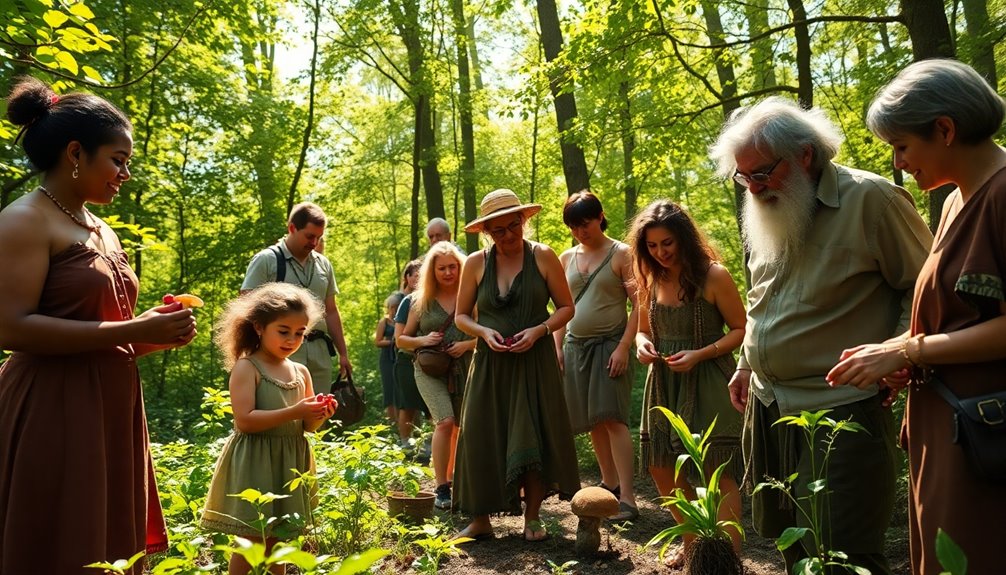
Foraging societies, often called hunter-gatherer societies, depend on wild plants and animals for food instead of farming or raising livestock. You'll find that these societies have a diverse diet, gathering fruits, nuts, roots, tubers, and berries while hunting various animals. This adaptability demonstrates their extensive ecological knowledge, enabling them to exploit multiple food sources effectively.
In foraging societies, food is consumed shortly after it's gathered or hunted, making it the only immediate return subsistence system. This means you won't see much food storage, as the focus is on immediate sustenance.
The community sizes are typically small, often ranging from 20 to 50 individuals. This creates an environment that minimizes pressure on resources and fosters social cohesion through sharing.
The social structures in foraging societies are generally egalitarian. You'll notice a cultural emphasis on sharing and cooperation, which helps to minimize wealth disparities and guarantees a more equal distribution of resources.
This way of life not only sustains individuals but also strengthens community bonds, reinforcing the importance of mutual support in their daily existence.
Historical Context and Evolution
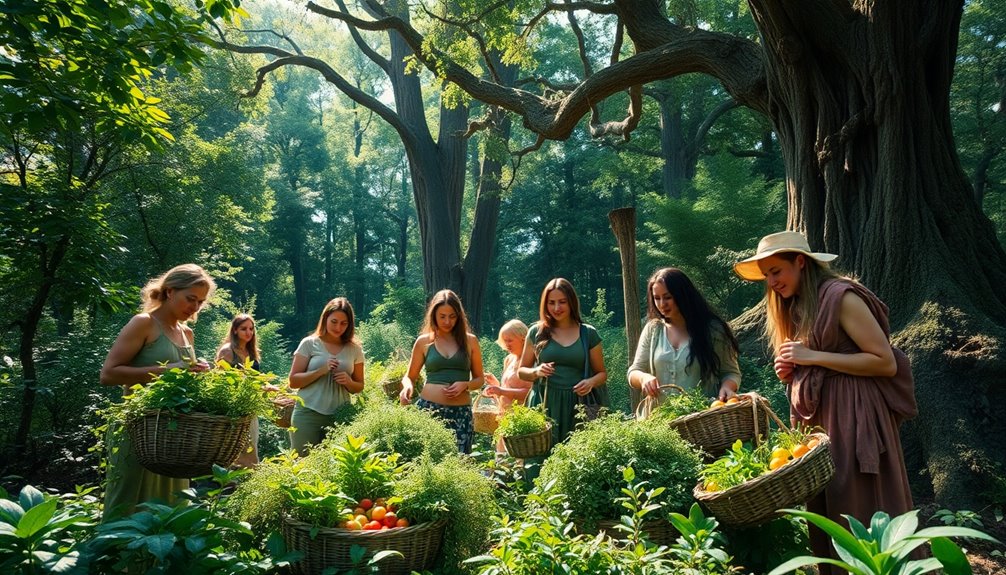
Foraging societies have roots that stretch back over 200,000 years, long before agriculture took hold.
As climate changes shifted landscapes, some groups began experimenting with plant cultivation around 12,000 years ago, marking the shift to agricultural practices.
Understanding these origins and the impact of environmental factors can shed light on how these societies evolved over time.
Origins of Foraging Societies
Long before agriculture shaped human societies, small groups of people thrived by hunting and gathering, adapting to their environments for survival. Foraging societies have existed for around 250,000 years, relying on the natural resources around them.
These foraging groups mastered the art of tracking animals and identifying edible plants, allowing them to sustain their communities without the need for farming.
While agriculture began to emerge around 12,000 years ago, driven by climate changes and resource availability, many foraging groups continued their traditional ways.
Archaeological evidence from sites like Gobekli Tepe and Stonehenge highlights the complexity of these societies, showing that even in pre-agricultural times, they'd organized social structures and engaged in ritual practices.
Additionally, protoagricultural practices suggest that some hunter-gatherers experimented with plant domestication, hinting at an evolutionary path toward agriculture.
However, the decline of these foraging cultures began about 500 years ago, influenced by environmental shifts, colonialism, and the spread of agricultural practices.
Your understanding of these origins sheds light on the resilience and adaptability of human societies throughout history.
Transition to Agriculture
As hunter-gatherer societies flourished for thousands of years, shifts in climate and resource availability began to reshape human lifestyles. About 12,000 years ago, the change from foraging to agriculture emerged, driven by the domestication of plants and animals. This gradual shift marked a significant change in social and economic structures.
In fertile regions, particularly river valleys, early agricultural communities started to thrive. Here are some key elements of this change:
- Resource Abundance: Favorable climates and plentiful wild food sources motivated communities to settle and experiment with cultivation.
- Social Change: As agriculture took root, populations grew, leading to the establishment of permanent settlements and more complex social hierarchies.
- Cultural Diversity: While some groups embraced farming, many foraging communities continued their traditional practices, showcasing the richness of human adaptation.
The decline of hunter-gatherer cultures became pronounced around 500 years ago, as agricultural societies expanded and altered ecosystems.
This change from foraging not only transformed human existence but also laid the foundation for the modern world, illustrating the diverse paths humanity has taken in response to changing environments.
Impact of Climate Change
Climate change has dramatically shaped the trajectory of human societies, particularly in how they adapted their lifestyles over millennia. Foraging communities faced significant challenges as shifting temperatures and changing ecosystems influenced resource availability. During the last Ice Age, these groups had to modify their foraging strategies to survive in varying environments, showcasing their resilience and adaptability.
As the Ice Age came to an end around 10,000 years ago, a warming period emerged, allowing for denser populations and resource exploitation in fertile regions. This change marked the gradual shift from foraging to agricultural practices.
Evidence indicates that climate variability, including droughts and periods of abundance, directly impacted the stability and success of foraging groups, affecting their social structures and mobility.
In some areas, the pressures of climate change ultimately led to the decline of foraging societies, as diminishing resources forced these communities to adopt sedentary agricultural lifestyles.
Understanding the impact of climate change on foraging communities reveals not just their adaptability but also the profound influence environmental factors have had on human development throughout history.
Characteristics of Foraging Life
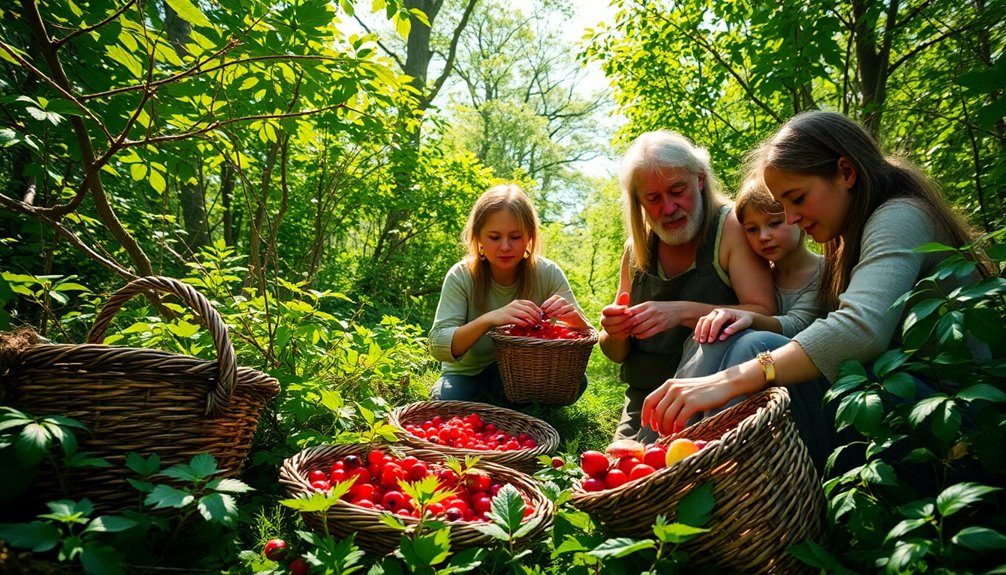
In foraging societies, you'll notice a nomadic lifestyle that drives groups to move regularly in search of food, creating a unique dynamic within their communities.
Social structure plays a significant role, with age often dictating respect and power rather than wealth or gender.
These characteristics shape not only daily life but also interactions with other groups, fostering connections and exchanges that enrich their culture.
Nomadic Lifestyle Dynamics
Foraging societies often thrive in dynamic environments, moving in small groups of 20-50 individuals to tap into seasonal food resources while evading predators. This nomadic lifestyle dynamics allows them to adapt to their surroundings effectively.
You'll find that these groups typically work only 4-6 hours a day, leaving plenty of leisure time for social interaction and physical activities.
Key characteristics of this lifestyle include:
- Childbirth Spacing: Foragers practice spacing between births to maintain manageable group sizes, ensuring sustainability in their nomadic lifestyle.
- Social Interactions: Connections with neighboring communities foster early trade networks and cultural exchanges, enriching their social dynamics.
- Respect for Elders: Age-based social divisions mean that older members are valued for their knowledge and experience, rather than wealth or gender.
Through these dynamics, foraging societies create a balanced way of life, prioritizing resource access while maintaining strong social bonds.
Social Structure and Roles
Social structures in foraging societies are often characterized by their egalitarian nature, where groups of 20-50 individuals work together closely. This small size fosters strong community bonds and resource sharing. Decisions are made collectively, minimizing wealth disparities and promoting social equality.
| Role | Description | Impact on Community |
|---|---|---|
| Men | Generally responsible for hunting | Provides protein, essential for survival |
| Women | Primarily gather plant-based foods | Contributes markedly to the diet |
| Elders | Hold higher social status due to experience | Influence resource distribution and community dynamics |
In these communities, gender roles can vary, but both men and women play vital parts in ensuring the group's survival. Elders often guide decision-making, drawing from their accumulated knowledge. Additionally, cooperative child-rearing practices strengthen social ties, ensuring that children receive care and protection from all members. This social structure allows for resilience against environmental challenges, highlighting the importance of collaboration in foraging societies.
Social Structure and Governance

How do the unique characteristics of foraging societies shape their social structure and governance? In these communities, you'll find an egalitarian social structure that minimizes wealth disparities and promotes sharing. This creates a strong sense of equality among members, which is essential for survival in resource-scarce environments.
Key aspects of their governance include:
- Elder Influence: Elders often hold higher social status, especially if they possess valuable skills in healing or rituals, guiding resource distribution.
- Cooperative Child-Rearing: This practice fosters social cohesion, allowing community members to support one another in raising children.
- Low Population Density: With typically fewer than five people per square mile, foraging societies reduce pressure on food resources, allowing for sustainable living practices.
In this setting, individuals work together to guarantee the well-being of the entire group.
While gender roles do play a part in tasks like hunting and gathering, the overall social structure emphasizes collaboration and shared responsibility.
Gender Roles in Foraging Communities
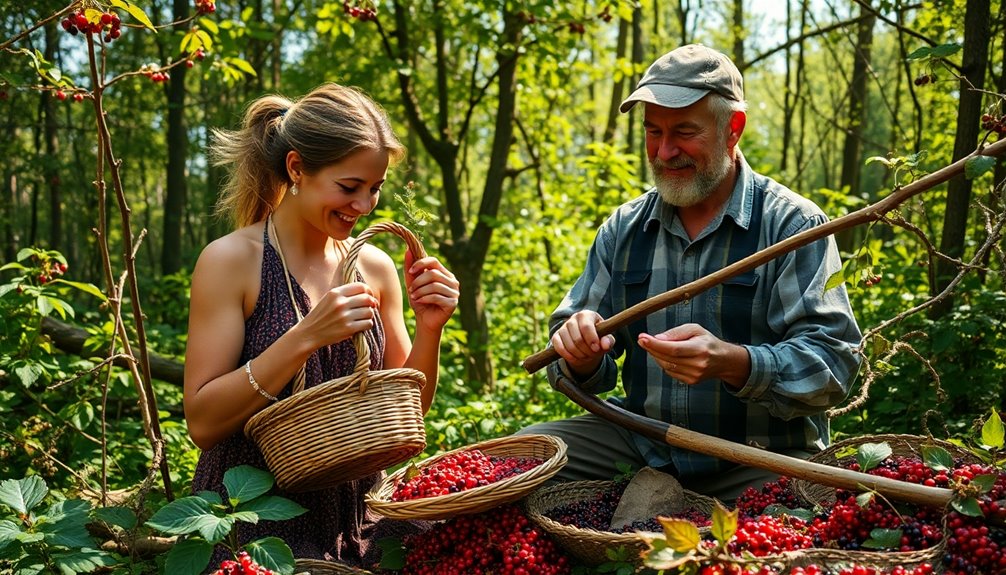
In foraging communities, you'll notice a clear division of labor based on gender, where men typically hunt large game and women gather essential plant-based foods.
This division not only shapes daily life but also influences social status, as hunting often garners more prestige despite the vital role of gathering.
Additionally, the collective effort in child-rearing reflects a shared responsibility that strengthens community ties and challenges traditional notions of hierarchy.
Division of Labor
Foraging societies often rely on a distinct division of labor based on gender, where men typically take on the role of hunting large game while women focus on gathering plant-based foods. This division of labor is essential for community survival and helps maintain a balanced diet. Notably, women can contribute up to 70% of the caloric intake through their gathering efforts.
Here are some key points about this division of labor:
- Egalitarian Social Structure: Foraging communities often minimize wealth disparities, promoting sharing and reinforcing the importance of both genders' contributions.
- Cultural Variability: Roles can vary greatly across different cultures, reflecting the adaptability of these societies to their environments.
- Elder Status: Elders, especially those knowledgeable in healing and rituals, hold higher status and influence resource distribution, further shaping social dynamics.
Understanding the division of labor in foraging societies provides insights into early human behavior and social organization. It highlights how men and women worked together to guarantee the community's survival, a dynamic that continues to inform archaeological interpretations of ancient populations.
Gender-Based Roles
Throughout history, gender roles in foraging communities have shaped the way societies functioned and thrived. In these societies, gender-based roles often dictate the division of labor, with men mainly hunting large game while women gather plant-based foods. This division can vary based on cultural context, but it's essential to recognize that women typically contribute considerably to the community's diet through gathering, often providing the majority of the food. Despite this, their contributions may not receive the same social recognition as those of male hunters.
Interestingly, gender roles in foraging societies tend to be more egalitarian compared to agricultural societies. You'll find less pronounced wealth disparities and a cultural emphasis on sharing resources, fostering a sense of community. Elders, regardless of gender, often hold a higher social status due to their knowledge and experience, influencing resource distribution.
Additionally, cooperative child-rearing practices in these communities showcase shared responsibilities across genders, enhancing social cohesion and supporting child development.
Social Status Influence
Gender roles in foraging communities greatly shape social status and influence how resources are distributed. In these societies, men often take on hunting roles, while women focus on gathering plant-based foods. However, this division can vary by culture, and the contributions of women are sometimes undervalued compared to the visible status associated with hunting.
Here are some key points about social status in foraging societies:
- Elders hold high status: Regardless of gender, elders command respect due to their accumulated knowledge and skills.
- Egalitarian principles: Foraging societies emphasize sharing and cooperation, minimizing wealth disparities and fostering community ties.
- Impact on archaeology: Understanding gender roles can help you interpret early human behavior and the importance of social structures.
These dynamics show that while gender roles influence social status, the overall structure of foraging communities promotes cooperation and resource sharing. By recognizing the value of both hunting and gathering, you can appreciate the complex interplay between gender roles and social status in these societies.
Dietary Practices and Resource Use
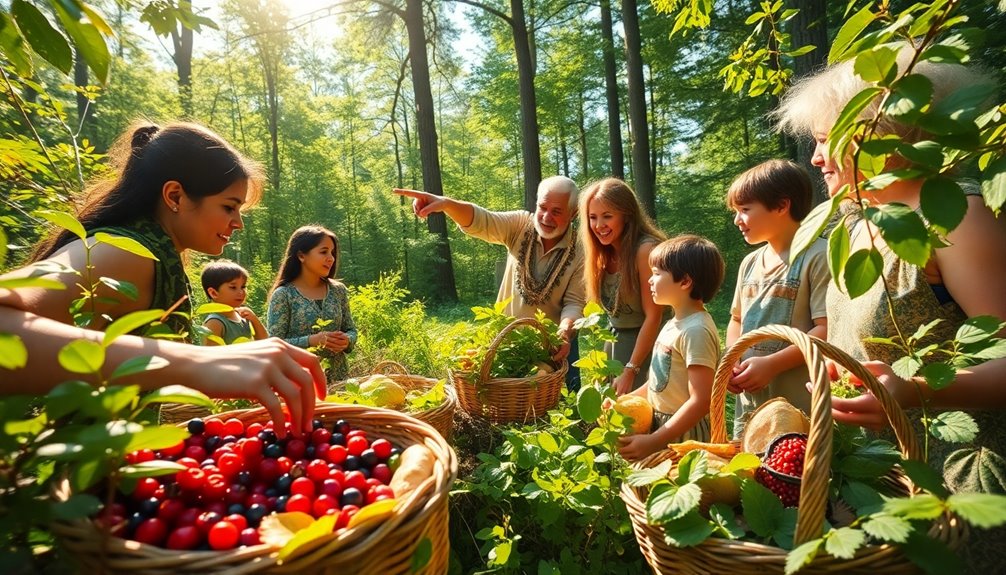
Diverse diets are a hallmark of foraging societies, where people gather a wide array of foods from their natural environment. Your dietary practices will typically include fruits, nuts, roots, tubers, and berries, supplying essential calories and nutrition.
You might also engage in hunting, which varies from targeting small game to large mammals, and fishing, where you could harvest everything from coastal shellfish to deep-sea fish.
Insects and worms, often overlooked, are significant in your diet and add to your overall caloric intake. For instance, Ach foragers are known to consume over 33 mammal species and 40 different plant species, demonstrating impressive ecological knowledge and resource utilization skills.
Resource scarcity in foraging societies shapes your social dynamics, fostering cooperation and sharing among group members. This cooperation is vital for maintaining social cohesion and ensuring the survival of the group.
Health and Life Expectancy

The health and life expectancy of foragers contrast sharply with those in modern societies, despite their varied diets and active lifestyles. While foragers typically had shorter life expectancies, averaging between 21 and 37 years, modern averages hover around 66 years.
However, the health benefits of their lifestyle shouldn't be overlooked. Foragers often enjoyed:
- Healthier diets rich in diverse foods, leading to better overall nutrition.
- Increased physical activity due to their nomadic way of life, which promoted fitness.
- Strong social interactions that fostered community bonds and emotional well-being.
Interestingly, some longevity studies suggest that certain hunter-gatherer populations might've had higher life expectancies than previously thought.
Though they faced challenges like violence and social complexities, their active lifestyle and nutritious diets contributed positively to their health.
Ultimately, while their life expectancy may seem low by modern standards, the foraging lifestyle offers valuable insights into the relationship between health, diet, and longevity.
You might find that embracing aspects of their way of life could enhance your own health and well-being.
Modern Resurgence of Foraging
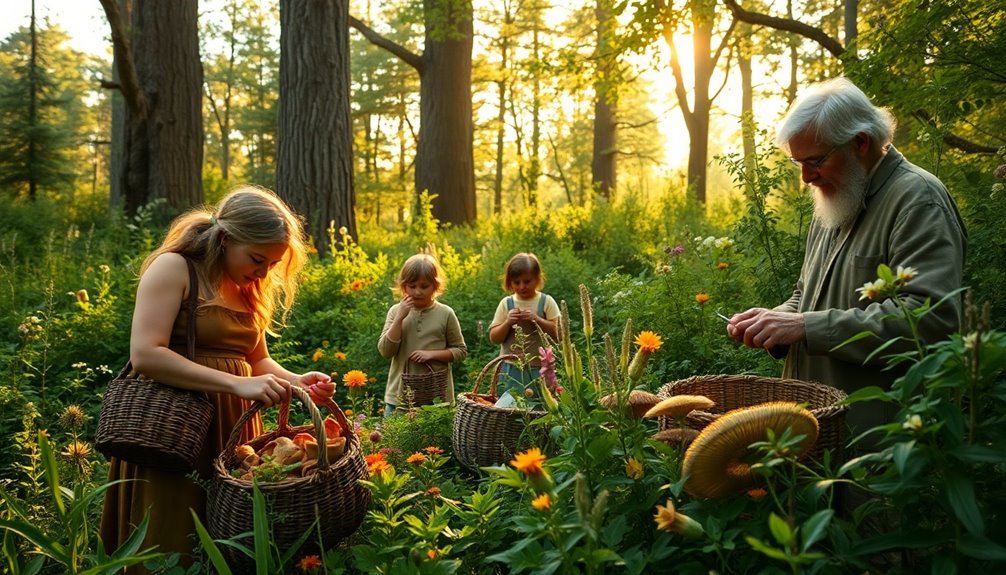
Revitalizing an ancient practice, foraging has seen a modern resurgence as people in urban areas seek to reconnect with nature and enhance self-sufficiency. You might find that engaging in foraging not only provides fresh, free food sources but also allows you to supplement your diet with seasonal and wild edibles.
As you explore local parks or even your backyard, you can discover a variety of plants and mushrooms that enrich your meals. Social media influencers have greatly contributed to this trend, sharing foraging techniques, recipes, and the many benefits of sourcing food from the wild.
This newfound interest encourages a deeper appreciation for natural resources and sustainable food practices. By embracing the modern resurgence of foraging, you're also participating in efforts to control invasive species and promote biodiversity, utilizing local ecosystems sustainably. Many foragers also benefit from understanding mushroom foraging techniques, which enhances their ability to safely identify and harvest edible varieties.
As you immerse yourself in this lifestyle, you'll likely develop a stronger connection to the environment and foster a more environmentally conscious approach to living. The modern resurgence of foraging isn't just about food; it's a movement toward a healthier, more self-reliant way of life, deeply rooted in nature.
Safety and Ethical Considerations
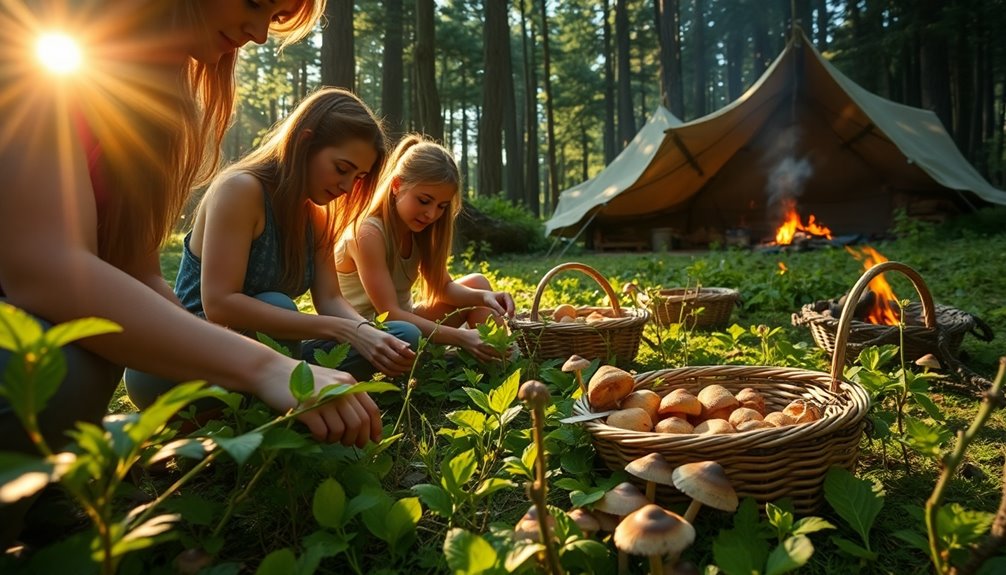
Foraging can be an exciting adventure, but it's crucial to prioritize safety and ethics while you explore. You need to be aware of the potential risks, especially when it comes to plant identification. Consuming the wrong plant can lead to serious health issues, so always confirm what you're foraging.
Here are some tips to keep you safe and ethical:
- Start with small portions of foraged foods to test for allergies and adverse reactions.
- Consult local guides or experts who can teach you about edible species and safe foraging techniques.
- Practice sustainable foraging by leaving some plants behind to encourage growth and maintain biodiversity. Additionally, consider using multi-functional gear to enhance your foraging experience and ensure you have the right tools on hand.
Archaeological Insights and Discoveries
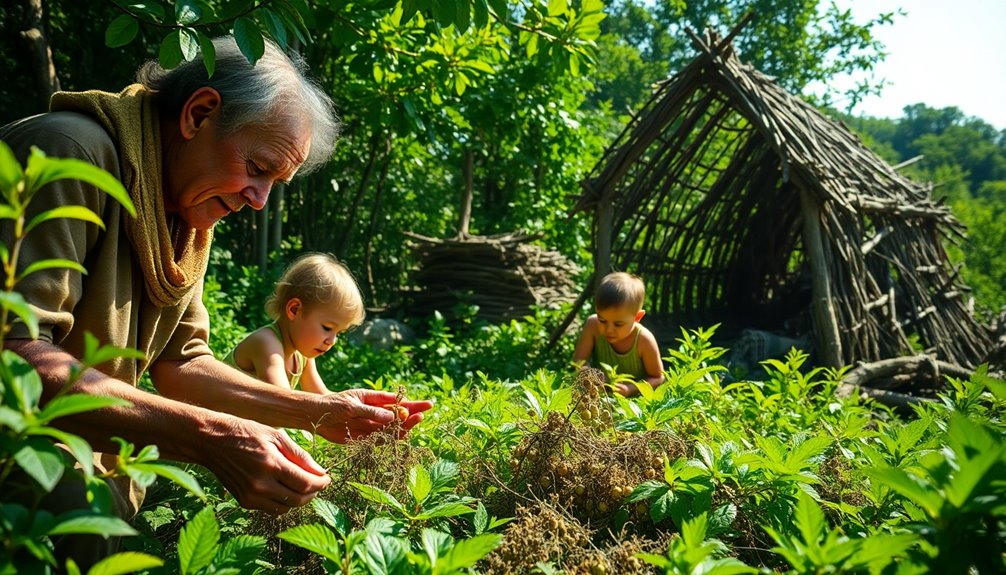
Archaeological discoveries offer fascinating insights into the lives of foraging societies, revealing their intricate social structures and rich cultural practices. Key sites like Gobekli Tepe and the Altamira cave paintings showcase the complex societal organization and artistic expression of these groups.
You'll find that excavations have uncovered evidence of foragers utilizing a diverse range of resources, with over 33 mammal species and 40 plant species consumed by groups like the Ach foragers.
Additionally, studies of sites like Stonehenge highlight the ritualistic and communal aspects of foraging communities, illustrating their social interactions and cultural practices. These archaeological insights indicate that foraging societies maintained trade networks and cultural exchanges with neighboring groups, greatly contributing to early social structures.
Moreover, the analysis of ancient tools and artifacts from these sites enhances our understanding of technological advancements and resource utilization in prehistoric human societies.
Frequently Asked Questions
What Are Foraging Societies?
Foraging societies are groups that rely on hunting and gathering for survival.
You'll notice they typically consist of small, mobile communities, often moving seasonally to find food. Their diets can be quite diverse, including fruits, nuts, and various animal species.
In these societies, social structures tend to be egalitarian, with men hunting and women gathering.
Despite the modern world, these groups showcase resilience and adaptability in utilizing natural resources for sustenance.
Do Foraging Societies Exist Today?
Yes, foraging societies do exist today.
You'll find groups like the San people and the Inuit still practicing traditional hunting and gathering. Even in urban areas, many individuals embrace modern foraging, seeking wild foods and natural ingredients.
This lifestyle emphasizes sustainability and environmental stewardship, showcasing a deep connection to nature.
However, these communities face challenges from land rights issues and industrial encroachment, threatening their traditional ways of life.
What Is Forage in Sociology?
In sociology, foraging refers to the practice of obtaining food by hunting, gathering, and fishing rather than through agriculture or livestock.
You rely on wild resources, utilizing your knowledge of the environment to find edible plants and animals. Foragers often work in groups, sharing their finds to promote cooperation and social bonds.
This lifestyle emphasizes sustainability and adaptation, allowing you to thrive within your ecosystem while maintaining a deep connection to nature.
What Is the Foraging Way of Life?
The foraging way of life involves hunting and gathering food directly from nature. You rely on your knowledge of local plants and animal behavior to find diverse resources like fruits, nuts, and game.
This lifestyle requires mobility, as you move to follow seasonal food availability. You'll often work collaboratively within small groups, sharing resources and responsibilities.
Gender roles might divide tasks, but both men and women play essential roles in ensuring the group's survival.
Conclusion
In exploring foraging societies, you glimpse a world where harmony with nature reigns, a melody of survival that dances through the ages. These communities, rooted in simplicity, teach us the art of living with purpose and connection. As modernity rushes by like a fleeting breeze, you can find inspiration in their wisdom, reminding you that beneath the chaos, there's beauty in the basics—a call to rediscover the rhythms of life and nurture the earth that sustains us.

